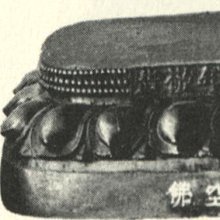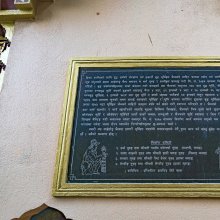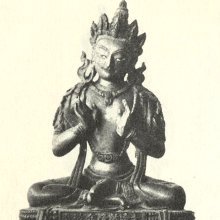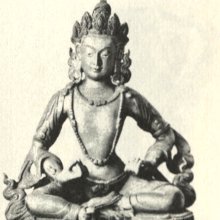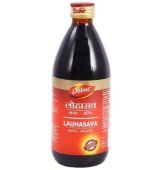Sha, Śa, Śā, Ṣā: 17 definitions
Introduction:
Sha means something in Hinduism, Sanskrit, the history of ancient India, Marathi, Jainism, Prakrit, Hindi, biology, Tamil. If you want to know the exact meaning, history, etymology or English translation of this term then check out the descriptions on this page. Add your comment or reference to a book if you want to contribute to this summary article.
The Sanskrit terms Śa and Śā and Ṣā can be transliterated into English as Sa or Sha, using the IAST transliteration scheme (?).
Images (photo gallery)
(+370 more images available)
In Hinduism
Vyakarana (Sanskrit grammar)
Source: Wikisource: A dictionary of Sanskrit grammar1) Śā (शा).—Conjugational sign(विकरण (vikaraṇa)) applied to the roots of the sixth conjugation (तुदादिगण (tudādigaṇa)) in all conjugational tenses and moods (i. e. the present, the imperfect,the imperative and the potential) before the personal-endings; cf. तुदादिभ्यः शः (tudādibhyaḥ śaḥ), P. III.1.77; this sign श (śa) (अ) has got the initial consonant श् (ś) as an indicatory one, and hence this अ (a) is a Sarvadhatuka affix, but, it is weak and does not cause गुण (guṇa) for the preceding vowel;
2) Śā.—tad. affix श (śa) in the sense of possession applied to the words लोमन् (loman) and others; e. g. लोमशः, रोमशः (lomaśaḥ, romaśaḥ) cf. P.V.2. 100;
3) Śā.—Krt affix (अ) applied to the roots पा, घ्रा, ध्मा, धे (pā, ghrā, dhmā, dhe) and दृश् (dṛś) when preceded by a prefix, to the roots लिम्प्, विन्द् (limp, vind) etc.not preceded by a prefix, and optionaily to दा (dā) and धा (dhā) of the third conjugation in the sense of 'an agent'; e.g. उत्पिबः, उत्पश्यः, लिम्पः, विन्दः ददः, दायः (utpibaḥ, utpaśyaḥ, limpaḥ, vindaḥ dadaḥ, dāyaḥ); cf. P.III.1.137-139.
--- OR ---
1) Ṣa (ष).—Consonant ष् (ṣ), the vowel अ (a) being added for facility of pronunciation;
2) Ṣa.—Compound-ending अ (a), substituted for the final of the word मूर्धन् (mūrdhan) at the end of a Bahuvrihi compound when the word मूर्धन् (mūrdhan) is preceded by द्वि (dvi) or त्रि (tri) e. g. द्विमूर्धः, त्रिमूर्धः (dvimūrdhaḥ, trimūrdhaḥ) cf. द्वित्रिभ्यां ष मूर्ध्नः (dvitribhyāṃ ṣa mūrdhnaḥ) P. V. 4.115
3) Ṣa.—A technical term for तत्पुरुषसमास (tatpuruṣasamāsa) in the Jainendra Vyakarana.
--- OR ---
1) Sa (स).—Short term for समास (samāsa) used by ancient grammarians ; the term is found used in the Jainendra Vyakarana also ; cf. ति्त्रक्का-रकाणां प्राक् सुवुप्तत्तेः कृद्भिः सविधिः (ti्trakkā-rakāṇāṃ prāk suvuptatteḥ kṛdbhiḥ savidhiḥ) Jain.. Pari. 100; cf. also राजा (rājā)sसे (se) ;
2) Sa.—Unadi affix स (sa) placed after the roots वॄ, तॄ, वद्, हन् (vṝ, tṝ, vad, han) and others; cf.Unadi-Sutras 342-349;
3) Sa.—tad. affix स (sa) in the quadruple senses (चातुरर्थिक (cāturarthika)) applied to the words तृण (tṛṇa) and others. e.g. तृणसः (tṛṇasaḥ); cf. P. IV.2.80;
4) Sa.—tad. affix स (sa) applied to the word मृद् (mṛd) when praise is intended e. g. मृत्सा, मृत्स्नाः (mṛtsā, mṛtsnāḥ); also cf. P. V. 4.41;
5) Sa.—Substitute for the preposition सम् (sam) before the words हित (hita) and तत (tata); cf. समो हितततयोर्वा लोपः (samo hitatatayorvā lopaḥ) M. Bh. on P. VI.1.144 Vart. I.
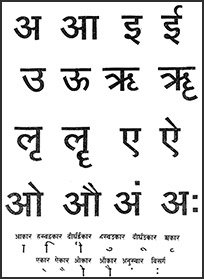
Vyakarana (व्याकरण, vyākaraṇa) refers to Sanskrit grammar and represents one of the six additional sciences (vedanga) to be studied along with the Vedas. Vyakarana concerns itself with the rules of Sanskrit grammar and linguistic analysis in order to establish the correct context of words and sentences.
Purana and Itihasa (epic history)
Source: archive.org: Puranic Encyclopedia1) Śa (श).—The letter Śa means to lie down and also Śaṃkara. 'Śam' means comfort or happiness. (Agni Purāṇa, Chapter 348).
2) Ṣa (ष).—Ṣa means noble, sublime. (Agni Purāṇa, Chapter 348).
3) Sa (स).—The sound 'Sa' means indirect; 'Sā, Lakṣmī (Goddess of wealth and prosperity) and 'sam' means hair. (Agni Purāṇa, Chapter 348).

The Purana (पुराण, purāṇas) refers to Sanskrit literature preserving ancient India’s vast cultural history, including historical legends, religious ceremonies, various arts and sciences. The eighteen mahapuranas total over 400,000 shlokas (metrical couplets) and date to at least several centuries BCE.
India history and geography
Source: Cologne Digital Sanskrit Dictionaries: Indian Epigraphical GlossarySa.—(IE 8-1), also written as saṃ; abbreviation of saṃvatsara. Note: sa is defined in the “Indian epigraphical glossary” as it can be found on ancient inscriptions commonly written in Sanskrit, Prakrit or Dravidian languages.
--- OR ---
Sā.—(EI 32), abbreviation of Sādhanika (q. v.). (PJS), abbreviation of Sāhu or Sādhu, designation of a member of the mercantile community often used in medieval inscriptions. Note: sā is defined in the “Indian epigraphical glossary” as it can be found on ancient inscriptions commonly written in Sanskrit, Prakrit or Dravidian languages.

The history of India traces the identification of countries, villages, towns and other regions of India, as well as mythology, zoology, royal dynasties, rulers, tribes, local festivities and traditions and regional languages. Ancient India enjoyed religious freedom and encourages the path of Dharma, a concept common to Buddhism, Hinduism, and Jainism.
Biology (plants and animals)
Source: Google Books: CRC World Dictionary (Regional names)1) Sha in India is the name of a plant defined with Parrotiopsis jacquemontiana in various botanical sources. This page contains potential references in Ayurveda, modern medicine, and other folk traditions or local practices It has the synonym Parrotia jacquemontiana Decne..
2) Sha in Myanmar is also identified with Acacia catechu It has the synonym Acacia catechu (L.f.) Willd. var. catechuoides (Roxb.) Prain (etc.).
3) Sha in Nigeria is also identified with Dacryodes edulis It has the synonym Canarium edule (G. Don) Hook. f. (etc.).
4) Sha in Peru is also identified with Zea mays It has the synonym Zea mays var. japonica (Van Houtte) A.W. Wood (etc.).
Example references for further research on medicinal uses or toxicity (see latin names for full list):
· Nomenclator Botanicus (1821)
· Proceedings of the American Academy of Arts and Sciences (1891)
· Escritos (1923)
· Phytologia (1978)
· A General History of the Dichlamydeous Plants (1832)
· The forest flora of North-West and Central India (1874)
If you are looking for specific details regarding Sha, for example side effects, health benefits, pregnancy safety, chemical composition, extract dosage, diet and recipes, have a look at these references.

This sections includes definitions from the five kingdoms of living things: Animals, Plants, Fungi, Protists and Monera. It will include both the official binomial nomenclature (scientific names usually in Latin) as well as regional spellings and variants.
Languages of India and abroad
Marathi-English dictionary
Source: DDSA: The Molesworth Marathi and English Dictionaryśa (श).—The thirtieth consonant and the first of the three sibilants. It is termed the palatal sibilant. It corresponds nearly with Sh in Shun.
--- OR ---
ṣa (ष).—The thirty-first consonant, and the second of the three sibilants. The sound is that of Sh but fuller or more prolonged. It must be acquired by the ear.
--- OR ---
sa (स).—The thirty-second consonant. It corresponds with S.
--- OR ---
sa (स).—m (The initial letter of sōdā) A covert term for a Scamp, scrub, or scurvy fellow.
--- OR ---
sa (स).—A preposition or inseparable prefix, signifying With, together with, along with; as sakāma, saguṇa, sadōṣa, saṭīka, saputra, sakuṭumba, sajala, sakampa, sadaya, sakapaṭa, sākāṅkṣa, sākāra, sādara, sāṅga, and innumerable others of which only the best established or the most useful will be inserted. sa will also be found prefixed to words not Sanskrit; as sakasa, sakaṇa, sakuḍī.
--- OR ---
sā (सा).—a (Or sahā. From ṣaṣ S) Six.
--- OR ---
sā (सा).—Abridged from asā Such, similar, like, and much used as affixed to adjectives and verbs, and, occasionally, to other of the parts of speech; as barāsā, mōṭhāsā, gōḍasā, and jāīsā, dēīsā, yēīsā. When attached to nouns some particularity arises; as āja malā nidrāśī vāṭalī-jēvaṇasēṃ vāṭalēṃ-upōṣaṇasēṃ vāṭalēṃ I feel I have had some sleep to-day -have made a meal -have fasted. Also pāūsasā vāṭalā, vārāsā vāṭalā, ūnhasēṃ vāṭalēṃ &c.
Source: DDSA: The Aryabhusan school dictionary, Marathi-Englishsa (स).—or-
--- OR ---
sa (स).—or -
--- OR ---
sa (स).—or-
--- OR ---
sa (स).—or-
--- OR ---
sā (सा).—or-
--- OR ---
sā (सा).—f -
--- OR ---
śa (श).—The thirtieth consonant.
--- OR ---
ṣa (ष).—The thirty-first consonant.
--- OR ---
sa (स).—The 32nd consonant. A prefix signi- fying With, &c.
Marathi is an Indo-European language having over 70 million native speakers people in (predominantly) Maharashtra India. Marathi, like many other Indo-Aryan languages, evolved from early forms of Prakrit, which itself is a subset of Sanskrit, one of the most ancient languages of the world.
Sanskrit dictionary
Source: DDSA: The practical Sanskrit-English dictionaryŚa (श).—
1) A cutter, destroyer.
2) A weapon.
3) Name of Śiva.
-śam Happiness; हर्तुर्याति न गोचरं किमपि शं पुष्णाति यत् सर्वदा (harturyāti na gocaraṃ kimapi śaṃ puṣṇāti yat sarvadā) Bhartṛhari 2.16.
Derivable forms: śaḥ (शः).
--- OR ---
Śa (श).—I. 4 P. (śāmyati, śānta)
1) To be calm, quiet or tranquil, be appeased or pacified (as a person); शाम्येत् प्रत्यपकारेण नोपकारेण दुर्जनः (śāmyet pratyapakāreṇa nopakāreṇa durjanaḥ) Kumārasambhava 2.4; काकुत्स्थमुद्दिश्य समत्सरोऽपि शशाम तेन क्षितिपाललोकः (kākutsthamuddiśya samatsaro'pi śaśāma tena kṣitipālalokaḥ) R.7.3; शान्तो लवः (śānto lavaḥ) Uttararāmacarita 6. 7; Bhartṛhari 2.75.
2) To cease, stop, come to an end; चिन्ता शशाम सकलाऽपि सरोरुहाणाम् (cintā śaśāma sakalā'pi saroruhāṇām) Bv.3.7; न जातु कामः कामानामुप- भोगेन शाम्यति (na jātu kāmaḥ kāmānāmupa- bhogena śāmyati) Manusmṛti 2.94 'is not satisfied'.
3) To be quelled, be extinguished or quenched; शशाम वृष्ट्यापि विना दवाग्निः (śaśāma vṛṣṭyāpi vinā davāgniḥ) R.2.14; Uttararāmacarita 5.7.
4) To desist, leave off (speaking &c.).
5) To put an end to, destroy, kill (also 9 P. in this sense) -Caus. (śamayati-te, but śāmayati- te in the sense of 'seeing', see śam II).
1) To appease, allay, calm, tranquillize, pacify, soothe; कः शीतलैः शमयिता वचनैस्तवाधिम् (kaḥ śītalaiḥ śamayitā vacanaistavādhim) Bv.3.1; संरम्भं शमयामास (saṃrambhaṃ śamayāmāsa) R.15. 85;17.55; Ś.5.7.
2) To put an end, to stop; वरेण शमितं लोकानलं दुग्धं हि तत्तपः (vareṇa śamitaṃ lokānalaṃ dugdhaṃ hi tattapaḥ) Kumārasambhava 2.56.
3) To remove, avert; प्रतिकूलं दैवं शमयितुम् (pratikūlaṃ daivaṃ śamayitum) Ś.1.
4) To subdue, tame, defeat, conquer, vanquish; शमयति गजानन्यान् गन्धद्विपः कलभोऽपि सन् (śamayati gajānanyān gandhadvipaḥ kalabho'pi san) V.5.18; R.9.12;11.59.
5) To kill, destroy, slay; कर्णस्यात्मजमग्रतः शमयतः (karṇasyātmajamagrataḥ śamayataḥ) Ve.5.5.
6) To quench, extinguish; शमितकुरुवंशप्रसविता (śamitakuruvaṃśaprasavitā) Pañcatantra (Bombay) 4.5; सुतप्तमपि पानीयं शमयत्येव पावकम् (sutaptamapi pānīyaṃ śamayatyeva pāvakam) H.1.85; Meghadūta 55.
7) To leave off, desist, cease. -II. 1 U. (śāmayati-te)
1) To see, look at, inspect.
2) To show, display.
Derivable forms: śam (शम्).
--- OR ---
Ṣa (ष).—(Many roots which begin with s are written in the Dhātupāṭha with ṣ to show that the s is changed to ṣ after certain prepositions. Such roots will be found under sa in their proper places.)
--- OR ---
Ṣa (ष).—a. Best, excellent.
2) Wise, learned.
-ṣaḥ 1 Loss, destruction.
2) End.
3) Rest, remainder.
4) Final emancipation.
5) Loss of knowledge.
6) Heaven.
7) Sleep.
8) A learned man.
9) A teat or nipple.
10) Hair.
11) Delivery (garbhavimocana).
--- OR ---
Sa (स).—ind. A prefix substituted for सह (saha) or सम्, सम, तुल्य (sam, sama, tulya), or सदृश (sadṛśa) and एक (eka) or समान (samāna), and compounded with nouns to form adjectives and adverbs in the sense of (a) with, together with, along with, accompained by, having, possessed of; सपुत्र, सभार्य, सतृष्ण, सधन, सरोषम्, सकोपम्, सहरि (saputra, sabhārya, satṛṣṇa, sadhana, saroṣam, sakopam, sahari) &c.; (b) similar, like; सधर्मन् (sadharman) 'of a similar nature'; so सजाति, सवर्ण (sajāti, savarṇa); (c) same; सोदर, सपक्ष, सपिण्ड, सनाभि (sodara, sapakṣa, sapiṇḍa, sanābhi) &c. -m.
1) A snake.
2) Air, wind.
3) A bird.
4) Short name for the musical note षड्ज (ṣaḍja) q. v.
5) Name of Śiva.
6) Of Viṣṇu.
7) (In prosody) A foot consisting of two short syllables followed by a long one.
8) God; L. D. B.
-sā The goddess Lakṣmī.
-sam 1 Knowledge.
2) Meditation.
3) A carriage-road.
4) A fence, an enclosure.
--- OR ---
Sa (स).—I. 1 P. (samati)
1) To be confused or agitated.
2) Not to be confused or agitated. -II. 1 U. (samayati- te) To be agitated.
Derivable forms: sam (सम्).
--- OR ---
Sā (सा).—
1) Name of Lakṣmī.
2) Of Pārvatī.
--- OR ---
Sā (सा).—1 U. (sāmayati-te) To appease, conciliate, soothe.
Derivable forms: sām (साम्).
Source: Cologne Digital Sanskrit Dictionaries: Edgerton Buddhist Hybrid Sanskrit DictionarySa (स).—(°-), inseparable prefix in ‘pleonastic’ positive use, as opp. of neg. (= Pali id., see Childers); sace(t), saca, sa- cchambita, saśakya, sāntarabahis, santika and sā° (°ke), see s.vv.: (lokapālān yakṣarākṣasa-)-gandharvabhu- jagagaṇa-saparivṛtān Lalitavistara 209.19 (prose), attended by crowds of…; paribubhukṣitā (so Senart em., mss. paribhuk°) sma sapipāsitā (Senart em. saṃpi°, but no such [compound] is recorded) sma Mahāvastu i.8.2 (prose), we are hungry, we are thirsty; ayoguḍā hi agnismiṃ yathā-d-iva (so mss.) sa- tāpitā (so mss.) Mahāvastu i.15.15 (verse); this could be interpreted as m.c. for saṃtāpitā(ḥ), which Senart reads (unmetrical(ly)) by em.; sa-pṛthagjanasevitaṃ (dharmaṃ) Mahāvastu i.33.13 (verse); sajaḍaḥ sajaḍataro bhavati Śikṣāsamuccaya 152.12 (prose), he is stupid, very stupid. Cf. sajyotibhūta, satejobhūta, which do not require similar interpretation. (In sayyathīdaṃ, °thāpi, etc., the pronoun sa, tad, is concerned.)
Source: Cologne Digital Sanskrit Dictionaries: Shabda-Sagara Sanskrit-English DictionaryŚa (श).—The thirtieth consonant of the Nagari alphabet and first of the three sibilants; it is termed the palatal sibilant, and corresponds to “Sh” pronounced softly, as in Shun; in the Roman character it is distinguished by an accent, as S.
--- OR ---
Śa (श).—m.
(-śaḥ) 1. A name of Siva. 2. A weapon. 3. A cutter, a destroyer. n. Adv.
(-śaṃ) or Ind. (śaṃ or śam) Happy, happily, auspiciously. E. śī to sleep or śī to pare, &c., aff. ḍa .
--- OR ---
Ṣa (ष).—The thirty-first consonant of the Nagari alphabet, and second sibilant, corresponding to Sh, pronounced in some schools K'h: this letter is usually the first element of the roots, the derivatives of which commence with sa .
--- OR ---
Ṣa (ष).—mfn.
(-ṣaḥ-ṣā-ṣaṃ) Best, excellent. m.
(-ṣaḥ) 1. A learned man, a teacher. 2. A nipple. 3. Loss, destruction. 4. Rest, remainder. 5. Loss of knowledge, previously acquired. 6. Eternal happiness, final emancipation. 7. Heaven, paradise. 8. Sleep. 9. End, term. 10. Hair. n.
(-ṣaṃ) 1. The embryo. 2. Patience, endurance. E. ṣo to destroy, &c., aff. kaṃ or ḍa and the consonant unchanged, &c.
--- OR ---
Sa (स).—The thirty-second consonant of the Nagari' Alphabet, corresponding to S.
--- OR ---
Sa (स).—m.
(-saḥ) 1. A snake. 2. Siva. 3. Vishnu. 4. Air, wind. 5. The abbreviated name of the musical note ṣaḍja. 6. A bird. 7. He, the nominative case masc. of tad the third personal pronoun: before many letters the Visarga is rejected. f.
(-sā) 1. The goddess Lakshmi. 2. She, the nominative case fem. of tad. n.
(-saṃ) 1. Knowledge. 2. Meditation. 3. A carriage-road. 4. A fence. Ind. 1. (In composition,) With, together with; being substituted for sam. or saha. 2. Like, similar, as in “sadharma” which means having similar duties. 3. Same, identical, as in “sodara”; combined with nouns it forms adjectives and adverbs; as sakopaḥ angry, sakopam angrily; sagarvaḥ proud, sagarvam haughtily; savinayaḥ modest, well-behaved, savinayam respectfully; sasambhramaḥ flurried, sasambhramam flurriedly, sānandaḥ joyful, sānandam joyfully, &c. E. ṣo to go, &c., aff. ḍa .
--- OR ---
Sā (सा).—f.
(-sā) 1. A name of Lakshmi. 2. The goddess Gauri. 3. She, (the third personal feminine pronoun or the feminine inflection of tad that, &c.) E. ṣo to destroy, &c., aff. ḍa .
Source: Cologne Digital Sanskrit Dictionaries: Benfey Sanskrit-English DictionaryṢa (ष).—[-ṣa], see pañcaṣa.
--- OR ---
Sa (स).—originally ‘One.’ I. See tad; in the Vedas appears also the loc. sasmin. Ii. As former part of comp. nouns. 1. With; see sa-kamala, adj. With lotus flowers. 2. The same, like, equal; see sa-dharman, adj. Of the same caste, etc.
— Cf. in (e. g. in ), (e. g. in ), (e. g. in ); [Latin] sum = eum, sam = eam, -sum, semin semper, simin simplex; [Gothic.] sa, so, A. S. se, sco.
Source: Cologne Digital Sanskrit Dictionaries: Cappeller Sanskrit-English DictionaryŚā (शा).—śiśāti śiśīte śyati [participle] śāta & śita (q.v.) sharpen, whet; excite, make eager, strengthen, promote; communicate, impart; present with, help to ([accusative] of [person or personal], [instrumental], [dative], or [genetive] of thing).
--- OR ---
Ṣa (ष).—(—°) = ṣaṣ.
--- OR ---
Sa (स).—1. [pronoun]-stem of 3d [person or personal] (only [nominative] sgl. [masculine] & [feminine] sa, sā & [locative] sasmin, supplying the forms of ta, q.v.).
--- OR ---
Sa (स).—2. (°— in adj. & [adverb], [opposed] a priv.) accompanied by, furnished with, having.
--- OR ---
Sa (स).—3. (°—) one, the same.
--- OR ---
Sā (सा).—1. v. san.
--- OR ---
Sā (सा).—2. si, syati, syate (only —°), sināti (sinoti), [participle] sita (q.v.) bind. [Causative] sāyayati (only —°).
Source: Cologne Digital Sanskrit Dictionaries: Monier-Williams Sanskrit-English Dictionary1) Śa (श):—1. śa the first of the three sibilants (it belongs to the palatal class, but in sound as well as euphonic treatment often corresponds to ṣ, though in some words pronounced more like s).
2) 2. śa (ifc.) = śaya (See giri-, vāri-, vṛkṣa-śa).
3) 3. śa m. = śastra, [cf. Lexicographers, esp. such as amarasiṃha, halāyudha, hemacandra, etc.]
4) = śiva, [cf. Lexicographers, esp. such as amarasiṃha, halāyudha, hemacandra, etc.]
5) n. See 2. śam.
6) Ṣa (ष):—1. ṣa the second of the three sibilants (it belongs to the cerebral class, and is sometimes substituted for s, and more rarely for ś, and occasionally interchangeable with kh; in sound it corresponds to sh in the English word shun; many roots which begin with s are written in the Dhātu-pāṭha with ṣ, [probably] to show that their initial s is liable to be cerebralized after certain prepositions).
7) 2. ṣa mfn. (only [cf. Lexicographers, esp. such as amarasiṃha, halāyudha, hemacandra, etc.]; for 3. ṣa See below) best, excellent
8) wise, learned
9) m. loss, destruction
10) loss of knowledge
11) end, term
12) rest, remainder
13) eternal happiness, final emancipation
14) heaven, paradise
15) sleep
16) a learned man, teacher
17) a nipple
18) = kaca
19) = mānava
20) = sarva
21) = garbhavimocana
22) n. the embryo
23) ([according to] to some) patience, endurance.
24) [from ṣaṣ] 3. ṣa mfn. = ṣaṣ ifc. (in pañca-ṣa q.v.)
25) Sa (स):—1. sa the last of the three sibilants (it belongs to the dental class and in sound corresponds to s in sin).
26) 2. sa (in prosody) an anapest (˘ ˘ ¯)
27) 3. sa (in music) an abbreviated term for ṣaḍ-ja (See p. 1109, col. 2).
28) 4. sa m. (only [cf. Lexicographers, esp. such as amarasiṃha, halāyudha, hemacandra, etc.]) a snake
29) air, wind
30) a bird
31) Name of Viṣṇu or Śiva
32) Sā (सा):—[from sa] a f. Name of Lakṣmi or Gaurī
33) Sa (स):—n. knowledge
34) meditation
35) a carriage road
36) a fence.
37) 5. sa mfn. ([from] √san) procuring, bestowing (only ifc.; cf. palu-ṣa and priya-sa).
38) 6 the actual base for the [nominative case] case of the 3rd [person] [pronoun] tad q.v. (occurring only in the [nominative case] sg. mf. [sa or sas, sā], and in the [Vedic or Veda] [locative case] [sasmin, [Ṛg-veda i, 152, 6; i, 174, 4; x, 95, 11]]; the final s of the [nominative case] m. is dropped before all consonants [except before p in [Ṛg-veda v, 2, 4], and before t in [Ṛg-veda viii, 33, 16]] and appears only at the end of a sentence in the form of Visarga; sa occasionally blends with another vowel [as in saīṣaḥ]; and it is often for emphasis connected with another [pronoun] as with aham, tvam, eṣa, ayam etc. e.g. so ham sa tvam, ‘I (or thou) that very person’; cf. under tad, p.434, the verb then following in the 1st and 2nd [person] even if aham or tvam be omitted e.g. sa tvā pṛcchāmi ‘I that very person ask you’ [Bṛhad-āraṇyaka-upaniṣad]; sa vai no brūhi ‘do thou tell us’ [Śatapatha-brāhmaṇa]; similarly, to denote emphasis, with bhavān e.g. sa bhavān vijayāya pratiṣṭhatām, ‘let your Highness set out for victory’ [Śakuntalā]; it sometimes [and frequently in the Brāhmaṇas] stands as the first word of a sentence preceding a rel. pronoun or [adverb] such as ya, yad, yadi, yathā, ced; in this position sa may be used pleonastically or as a kind of ind., even where another gender or number is required e.g. sa yadi sthāvarā āpo bhananti, ‘if those waters are stagnant’ [Śatapatha-brāhmaṇa]; in the Sāṃkhya sa, like eṣa, ka, and ya, is used to denote Puruṣa, ‘the Universal Soul’), [Ṛg-veda] etc. etc.
39) cf. [Zend] hā, hA; [Greek] ὁ, ἡ.
40) 7. sa ind. (connected with saha, sam, sama, and occasionally in [Bhāgavata-purāṇa] standing for saha with [instrumental case]) an inseparable prefix expressing ‘junction’, ‘conjunction’, ‘possession’ (as opp. to a [privative]), ‘similarity’, ‘equality’
41) (and when compounded with nouns to form adjectives and adverbs it may be translated by ‘with’, ‘together or along with’, ‘accompanied by’, ‘added to’, ‘having’, ‘possessing’, ‘containing’, ‘having the same’ cf. sa-kopa, sāgni, sa-bhāya, sa-droṇa, sa-dharman, sa-varṇa; or it may = ‘ly’, as in sa-kopam, ‘angrily’, sopadhi, ‘fraudulently’), [Ṛg-veda]; etc.
42) cf. [Greek] ἁ in ἁπλοῦς; [Latin] sim in simplex; sem in semel, semper [English] same.
43) [from sa-kaṅkaṭa] a (to be similarly prefixed to the following) :
44) [from sa-gajāroha] b (to be similarly prefixed to the following) :
45) [from sa-cakita] c (to be similarly prefixed to the following) :
46) [from sa-takṣan] d (to be similarly prefixed to the following) :
47) [from sa-daṃśa] e (to be similarly prefixed to the following).
48) [from sa-dhana] f (to be similarly prefixed to the following) :
49) [from san] g See 5. sa, p. 1111, col. 2.
50) [from sa-nanda] h (to be similarly prefixed to the following) :
51) [from sa-pakṣa] i (to be similarly prefixed to the following) :
52) [from sa-bandha] j (to be similarly prefixed to the following) :
53) [from sa-bhaktikam] k (to be similarly prefixed to the following) :
54) [from sa-ya] l (to be similarly prefixed to the following) :
55) [from sa-rakta] m (to be similarly prefixed to the following)
56) [from sa-lakṣa] n (to be similarly prefixed to the following) :
57) [from sa-vaṃśā] o (to be similarly prefixed to the following) :
58) [from sa-śakala] p (to be similarly prefixed to the following) :
59) [from sa-saṃrambha] q (to be similarly prefixed to the following)
60) [from sahaṃsa-pāta] r (to be similarly prefixed to the following) :
61) Sā (सा):—1. sā f. of 4. sa q.v.
62) 2. sā f. of 6. sa q.v.
63) 3. sā (weak form of √san), giving, bestowing, granting (cf. ap-, aśva-sā etc.)
64) 4. sā = √so q.v.
Source: Cologne Digital Sanskrit Dictionaries: Yates Sanskrit-English Dictionary1) Śa (श):—Sh, the first of the sibilant class.
2) (śaḥ) 1. m. A name of Shiva; a weapon. n. Happily.
3) Ṣa (ष):—Sh, the second letter of the sibilant class.
4) (ṣaḥ) 1. m. A learned man; nipple; loss; remainder; final bliss; sleep; end. n. Embryo; patience. a. Excellent.
5) Sa (स):—s. Third of the sibilant class.
6) (saḥ) 1. m. A snake, Vishnu; Shiva; wind; he. 1. f. Lakshmī; she. n. Knowledge; a fence; road. In composition, With, see the next word.
7) Sā (सा):—(sā) 1. f. A name of Lakshmī, Gaurī, pro. She.
[Sanskrit to German]
Sanskrit, also spelled संस्कृतम् (saṃskṛtam), is an ancient language of India commonly seen as the grandmother of the Indo-European language family (even English!). Closely allied with Prakrit and Pali, Sanskrit is more exhaustive in both grammar and terms and has the most extensive collection of literature in the world, greatly surpassing its sister-languages Greek and Latin.
Hindi dictionary
Source: DDSA: A practical Hindi-English dictionary1) Śa (श) [Also spelled sh]:—-the first of the conventional sibilant—trio ([śa, ṣa, sa]) of the Devnagri: alphabet. In current Hindi sound-pattern, however, the cerebral ([ṣa]) has merged its identity into the palatal sibilant ([śa]).
2) Ṣa (ष) [Also spelled sh]:——the second of the sibilant-trio ([śa, ṣa, sa]) of the Devnagri: alphabet. In Modern Hindi sound pattern, however, this has lost its identity and is invariably pronounced as palatal sibilant ([śa]) rather than as cerebral (as it originally was).
3) Sa (स) [Also spelled s]:——the last of the sibilant-trio ([śa, ṣa, sa]) of the Devnagri: alphabet. In Hindi sound-pattern, this one happens to be the most dominant of the three; used as a prefix to mean accompanied by, along with, with (as [sapatnīka], accompanied by one’s wife); belonging to the same, alike; having affinity (as [sagotra]); good (as [sapūta]).
4) Sā (सा):—(ind) like, similar to, resembling, following; (nm) a basic note of the musical gamut.
...
Prakrit-English dictionary
Source: DDSA: Paia-sadda-mahannavo; a comprehensive Prakrit Hindi dictionary1) Sa (स) in the Prakrit language is related to the Sanskrit word: Śvan.
2) Sa (स) also relates to the Sanskrit word: Svar.
3) Sa (स) also relates to the Sanskrit word: Sat.
4) Sa (स) also relates to the Sanskrit word: Sva.
Prakrit is an ancient language closely associated with both Pali and Sanskrit. Jain literature is often composed in this language or sub-dialects, such as the Agamas and their commentaries which are written in Ardhamagadhi and Maharashtri Prakrit. The earliest extant texts can be dated to as early as the 4th century BCE although core portions might be older.
Kannada-English dictionary
Source: Alar: Kannada-English corpusŚa (ಶ):—
1) [noun] (gen. pronounced with the vowel 'ಅ') the forty fourth letter of Kannaḍa alphabet and the thirtieth consonant.
2) [noun] (math.) a symbol for the number five.
--- OR ---
Ṣa (ಷ):—
1) [noun] (gen. pronounced with the vowel 'ಆ') the forty fifth letter of Kannaḍa alphabet and the thirty first consonant.
2) [noun] (math.) a symbol for the number six.
--- OR ---
Sa (ಸ):—[noun] (gen. pronounced with the vowel 'ಅ') the forty sixth letter of Kannaḍa alphabet and the thirty second consonant.
--- OR ---
Sa (ಸ):—
1) [noun] the abbrev. form of salage(or, solage), a measure of grain or liquid.
2) [noun] that extent of land which requires a salage seeds for being sown with.
--- OR ---
Sa (ಸ):—
1) [noun] (pros.) a metrical foot consisting of two short syllablic instants followed by a long one (uu-); anapaestus.
2) [noun] (mus.) the first of the seven musical notes which is the base pitch.
--- OR ---
Sā (ಸಾ):—
1) [verb] to cease to live; to die.
2) [verb] to become utterly weak.
3) [verb] to stop from going forward.
4) [verb] (fig.) to make great efforts or attempts; to strive; to struggle.
Kannada is a Dravidian language (as opposed to the Indo-European language family) mainly spoken in the southwestern region of India.
See also (Relevant definitions)
Starts with (+8759): Catakopan, Sababa, Sabaka, Sabali, Sabalika, Sabalikarana, Sabdi, Sabhash, Sabudana, Saca, Saci, Sadaga, Sadaha, Sadaka, Sadamsha, Sadana, Sadara, Sadari, Sadartha, Sadashva.
Ends with (+9743): A-cata-bhata-pravesha, A-catta-bhatta-pravesha, A-shuddha-paksha, Abadamsha, Abalisha, Abasa, Abbhaksha, Abdhijhasha, Abhaksha, Abhakshyabhaksha, Abhangashlesha, Abharanachattranirghosha, Abharanachhattranirghosha, Abhasa, Abhayadaganesha, Abhayadavighnesha, Abhayaghosha, Abhibhuyayasha, Abhidesha, Abhidhanakomsha.
Full-text (+18269): Sam, Savesha, Sarosha, Vyakosha, Romasha, Nirasa, Abhyasa, Savishesha, Avasa, Niranukrosha, Atilomasha, Kritapaurusha, Alekhyashesha, Sasadhvasa, Hatasha, Kritavesha, Nistusha, Yashahshesha, Nirakrosha, Suvesha.
Relevant text
One of your search terms exceeds the minimun character amount per search term. This amount currently equals 2.
No search results for Sha, Śa, Sa, Ṣa, Sā, Śā, Ṣā; (plurals include: Shas) in any book or story.
Related products
(+20 more products available)
